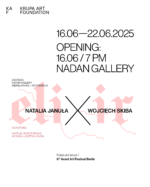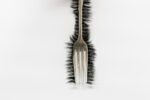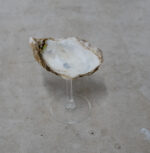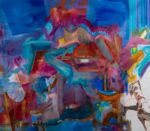Program
KAF
(PL) 16–21.06.2025 | Berlin | NADAN Gallery
The titular ELIXIR is a blend of images emerging from perceptual distortions mixed with visual inspirations drawn from art history and pop culture in Wojciech Skiba’s painting, alongside various forms of alternative beings shaped from the fusion of organic and synthetic matter in Natalia Januła’s works.
Wojciech Skiba’s Psychotic Chic, unusually for this artist, forms a coherent painting cycle, carefully planned together with the titles of the works. It is a process of working through self-destructiveness, an attempt to order chaos and pain, striving toward a gentler form, partly thanks to a consistent and limited colour palette. Visual references to eroticism juxtapose the initial phase of a psychotic state with sexual experiences – a pleasure that stretches the integrity of identity. We are never fully certain what we see. Shapes dissolve in a play of colours, glowing glazes, mutual transformations, and the plasticity of consciousness.
In Psychotic Chic, the painter aims for a form of expression more accessible to the viewer, combining diverse elements of pop culture – from current trends such as the recurring neo-rococo style, through gothic fonts and fashion-like repeated texts, to visual quotations from painting and poetry. The painting But on the window licks the night, tells of the awareness that the hard effort invested in the process of healing and building a sense of security is separated from darkness by only a thin pane of glass. Its title is taken from the poem Fear by Harold Hart Crane. On the canvas, we see a garden, the artist’s hat, watermelons he cultivated, and girls from the streets of Los Angeles, traced from a photograph by Jimmy Bonks. Their attractiveness is like fragile glass hiding the darkness of the street. Meanwhile, in the painting I put the hot in psychotic, the artist combined his self-portrait with the silhouettes of naked figures from Nicolas Poussin’s Triumph of Neptune. Similarly, many other works also contain numerous references and subtle clues left by the artist. Even when recognised, simple interpretations are not offered. The most important part of this story unfolds at the level of painterly expression — in the noise of forms, fluid transitions from abstraction to figuration, and coloristic-formal experiments.
Bittersweet – Natalia Januła
We live in a disenchanted culture—deprived of metaphorical elements, where the realm of fantasy is an area that barely interests us. This disconnection doesn’t help the activation of self-healing processes, including those within our relationship to the environment. Instead, we try at all costs to control reality, as if it could not exist without our contribution. Not surprisingly, many contemporary psychological analyses highlight control as a natural element of the psyche’s self-defence. In the face of a world deeply immersed in its overdose, Natalia Januła’s works construct an alternative realm of fantasy, often presenting what has been abjected by consciousness. They draw attention to letting go, to accepting strangeness, to re-enchanting the realm of darkness—not by turning away from it or ignoring it, but by acknowledging it as it is. One could call it an invitation to care for the hygiene of the soul, just as we are used to tending to its outer shell—the one we shed each night.
The kinetic elements and the recurring motif of the egg point not so much to the symbolic beginning of new life, but rather to the idea of the constant emergence of new, alternative universes. The artist references motifs present in many cultural cosmological mythologies. The egg-like shape of the cosmos appears in Indo-European traditions, in Africa, in Asia, in medieval accounts, and Slavic beliefs—its origins trace back to antiquity. In this way, the “cosmic egg” in Natalia Januła’s installations becomes a symbol of other, parallel dimensions of time, including spiritual ones. Januła’s works blur not only the boundaries between inside and outside, but also those between the organism, the utilitarian object, secretion, substrate, matter, structure, and decay. Natural surfaces—industrialised by humans—such as black sand or stone, typically used to cultivate organisms that breathe water, here become part of a semi-dead scenario, where the cultivator may at times feel like a fish living alone in an aquarium.
The series of works presented as part of the exhibition can be described as a bouquet of flavours. The titular elixir consists of Bittersweet emotional compositions. The mixture, though seemingly shrouded in a magical aura, is less a potion and more a healing syrup. It’s more like an essence drawn from beneath the skin—tears, blood, secretions, remnants—concentrating fear, desire, loss, and longing. The poet Zbigniew Herbert once wrote of tears: “True tears are hot, which makes them very difficult to separate from the face. Once brought to a solid state, it turns out they are very fragile”—a surreal image that captures the illogical labyrinths through which they flow. In an effort to capture their ephemerality, Januła juxtaposes seemingly unrelated materials in surprising combinations. What emerges from the earth pushes to the surface; what descends from the air becomes grounded and solidifies into mass. The Bittersweet series draws inspiration from the idea of a “cabinet of curiosities” and inhabits the fragile landscape of the human psyche, which— unlike inanimate objects—is never seen as sufficiently correct or stable.
The exhibition is part of the Avant Art Festival taking place in Berlin from June 16 to 23, 2025.






